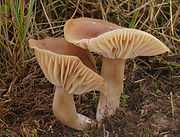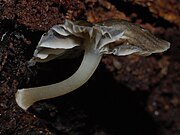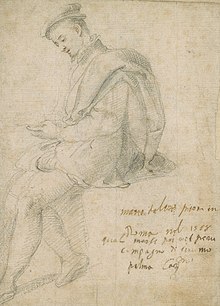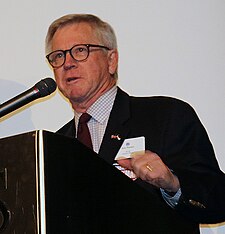큐포필루스
Cuphophyllus| 큐포필루스 | |
|---|---|
 | |
| 쿠포필루스 프라텐시스 | |
| 과학적 분류 | |
| 왕국: | |
| 중분류: | |
| 클래스: | |
| 주문: | |
| 패밀리: | |
| 속: | 큐포필루스 |
| 모식종 | |
| 쿠포필루스 프라텐시스 (Pers.) 본(1985년) | |
큐포필러스는 히그로포라과에 속하는 한천균의 한 속이다.큐포필루스 종은 영어로 왁스캡이라고 알려진 그룹에 속하며, 때로는 북미에서는 왁스캡 또는 뉴질랜드에서는 왁스길이라고도 합니다.유럽에서, 큐포필루스 종은 밀랍 초원의 전형적인 종으로, 농업 관행이 바뀌면서 서식지가 감소하고 있다.그 결과, C. canescens, C. colemannus,[1] C. lacmus, 그리고 C. lepidopus의 4종류가 세계적인 보존 관심사이며 IUCN 적색 목록에 "취약"[2]으로 등록되어 있다.
분류법
역사
이 [3]속은 1985년 프랑스의 균사학자 마르셀 본에 의해 기술되었지만,[4] 이후 일부 관계자들에 의해 Hygrocybe와 동의어가 되었다.큐포필루스 종은 때때로 카마로필루스속(Fr. P. Kumm.)으로 언급되지만, Donk(1962년)에 의해 주장되었듯이, 카마로필루스의 모식종은 아가리쿠스 카마로필루스 Al이어야 한다.& 슈바인.그 속명이 [5]유래한 종이것은 A. camarophylus가 Hygroporus 종이기 때문에 Camarophylus sensu stricto가 Hygroporus의 동의어라는 것을 의미합니다.이것은 현재 모든 표준 [6][7][4]당국에 의해 받아들여지고 있다.그러나 싱어(Singer)는 카마로필루스(Camarophylus)의 모식종으로 [8]아가리쿠스 프라텐시스(= Cuphyllus pratensis)를 제안했는데, 이는 카마로필루스 센서(Camarophylus sensu Singer)가 큐포필루스(Cuphylus)와 동의어라는 것을 의미한다.
현황
최근의 분자 연구는 DNA 배열의 분지학적 분석에 근거해, [9][10][11]큐포필러스가 단열체이며, 습윤체 감각과 구별되는 자연적인 그룹을 형성하고 있다는 것을 보여준다.
묘사
종들은 보통 백색, 회색 또는 갈색 담자(과일 몸체)를 만들어내며, 종종 탈회성 층상(glamellae)과 함께 다른 대부분의 왁스캡과 구별됩니다.염색체속의 종들은 표면적으로는 비슷하지만 종종 더 밝은 색을 [4]띤다.
서식 및 분포
유럽에서 큐포필루스 종은 일반적으로 농업적으로 개량되지 않은 짧은 풀밭(목초지와 잔디밭 포함)에서 발견된다.다른 곳에서는 삼림지대에서 가장 많이 발견된다.그 속은 국제적이다.[4]
경제적 사용
유럽의 흔한 왁스캡 종 중 하나인 C. pratensis의 과일 몸체는 먹을[4] 수 있고 널리 수집되며, 때때로 지역 시장에 판매된다.
종.
- C. acutoides
- 아도니스
- 알비도시네레우스
- 앙구스티폴리우스
- 항우울제
- 시라토시
- 오란티우스
- 담쟁이덩굴
- 버클리
- C. 바이컬러
- C. bondii
- 북방어류
- C. 캔스켄스
- 뇌파충류
- 시네렐루스
- 시네레우스
- 시트리노팔리두스
- 콜레만니아누스
- 코모수스
- 다. 에스테리아
- C. 플라비프
- C. 플라비페소이데스
- C. fornicatus
- 후센시스
- 그리세오루프스켄스
- 다. 히드로시보이드
- 라쿠스
- C. 라마룸
- 흰개구리
- 성운
- 네오프라텐시스
- 네오프라텐시스
- 오크레이오팔리두스
- 페글레리
- 다. 프라텐시스
- 다. 가성파리지스
- C. radiatus
- 레이니렌시스
- C. 리커플
- 리겔리아속
- 로제아스켄스
- 루소코리아케우스
- C. 서브레이더스
- 다. 아위반증
- umbrinus
- 처녀자리
「 」를 참조해 주세요.
레퍼런스
- ^ Jordal JB, Larsson E (2021). "Cuphophyllus atlanticus (Hygrophoraceae, Agaricales) — a new sister species to the North American C. canescens". Agarica. 42: 39–48.
- ^ "Cuphophyllus. The IUCN Red List of Threatened Species".
- ^ "Cuphophyllus (Donk) Bon". Index Fungorum. CAB International. Retrieved 2011-12-29.
- ^ a b c d e Boertmann D. (2010). The genus Hygrocybe (2nd ed.). Copenhagen: Danish Mycological Society. p. 200. ISBN 978-87-983581-7-6.
- ^ Donk MA (1962). "The generic names proposed for the Agaricaceae". Beihefte zur Nova Hedwigia. 5: 1–320.
- ^ "Camarophyllus (Fr.) P. Kumm". Index Fungorum. CAB International. Retrieved 2011-12-29.
- ^ "Camarophyllus (Fr.) P. Kumm". MycoBank. International Mycological Association. Retrieved 2011-12-29.
- ^ Singer R. (1949). "The Agaricales in modern taxonomy". Lilloa. 22: 1–832.
- ^ Matheny PB, Curtis JM, Hofstetter V, Aime MC, Moncalvo JM, Ge ZW, Slot JC, Ammirati JF, Baroni TJ, Bougher NL, Hughes KW, Lodge DJ, Kerrigan RW, Seidl MT, Aanen DK, DeNitis M, Daniele GM, Desjardin DE, Kropp BR, Norvell LL, Parker A, Vellinga EC, Vilgalys R, Hibbett DS (2006). "Major clades of Agaricales: a multilocus phylogenetic overview" (PDF). Mycologia. 98 (6): 982–95. doi:10.3852/mycologia.98.6.982. PMID 17486974. Archived from the original (PDF) on 2016-03-03.
- ^ Babos M, Halász K, Zagyva T, Zöld-Balogh Á, Szegő D, Bratek Z (2011). "Preliminary notes on dual relevance of ITS sequences and pigments in Hygrocybe taxonomy". Persoonia. 26: 99–107. doi:10.3767/003158511X578349. PMC 3160800. PMID 22025807.
- ^ Lodge DJ, Padamsee M, Matheny PB, Aime MC, Cantrell SA, Boertmann D, et al. (2014). "Molecular phylogeny, morphology, pigment chemistry and ecology in Hygrophoraceae (Agaricales)". Fungal Diversity. 64 (1): 1–99. doi:10.1007/s13225-013-0259-0.







